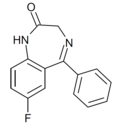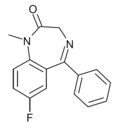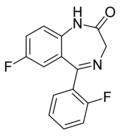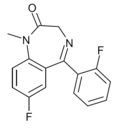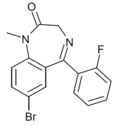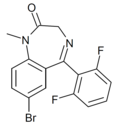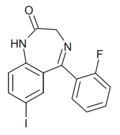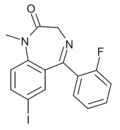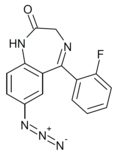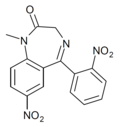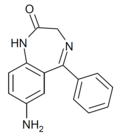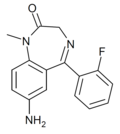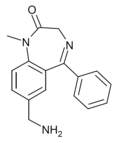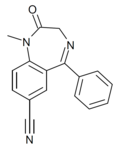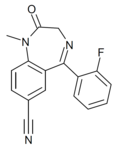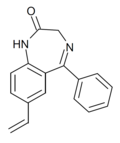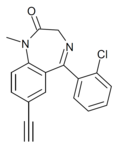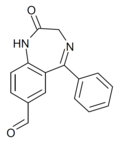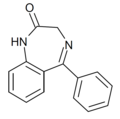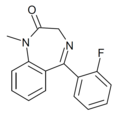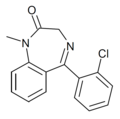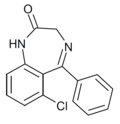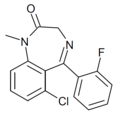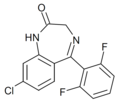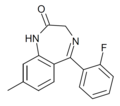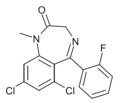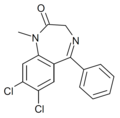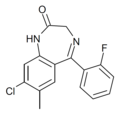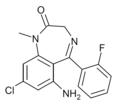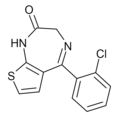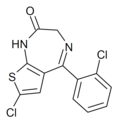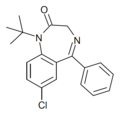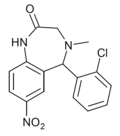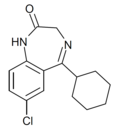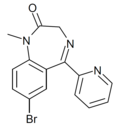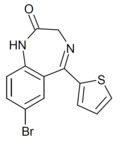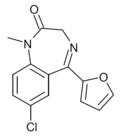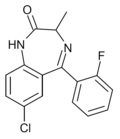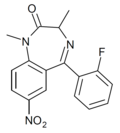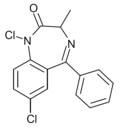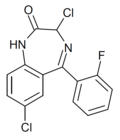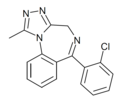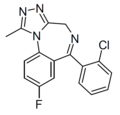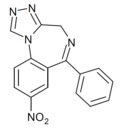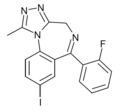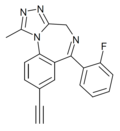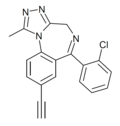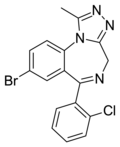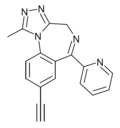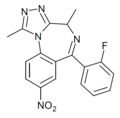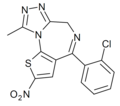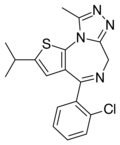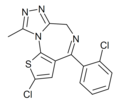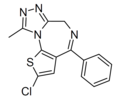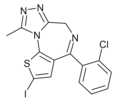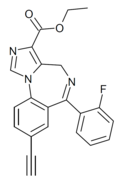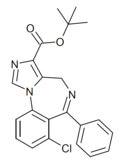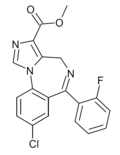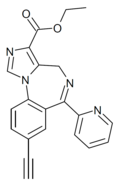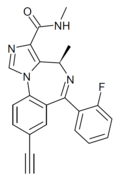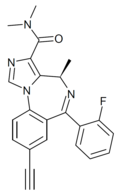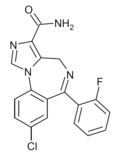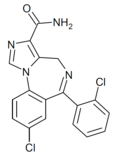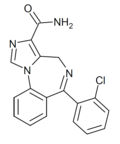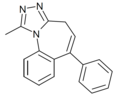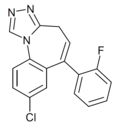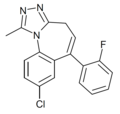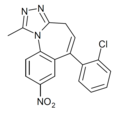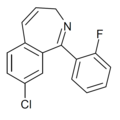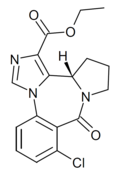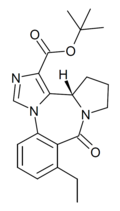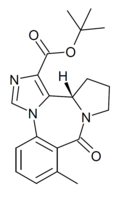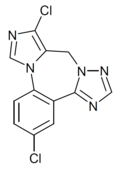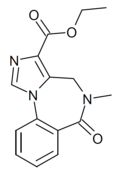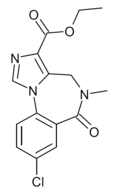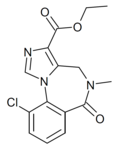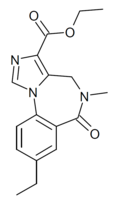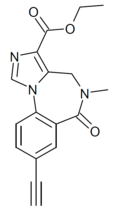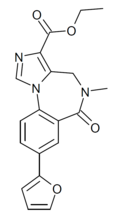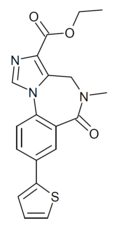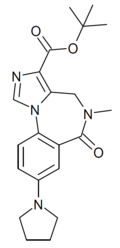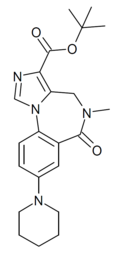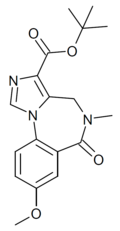List of benzodiazepines

| Benzodiazepines |
|---|
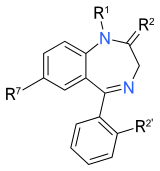 |
The tables below contain a sample list of benzodiazepines and benzodiazepine analogs that are commonly prescribed, with their basic pharmacological characteristics, such as half-life and equivalent doses to other benzodiazepines, also listed, along with their trade names and primary uses. The elimination half-life is how long it takes for half of the drug to be eliminated by the body. "Time to peak" refers to when maximum levels of the drug in the blood occur after a given dose. Benzodiazepines generally share the same pharmacological properties, such as anxiolytic, sedative, hypnotic, skeletal muscle relaxant, amnesic, and anticonvulsant effects. Variation in potency of certain effects may exist amongst individual benzodiazepines. Some benzodiazepines produce active metabolites. Active metabolites are produced when a person's body metabolizes the drug into compounds that share a similar pharmacological profile to the parent compound and thus are relevant when calculating how long the pharmacological effects of a drug will last. Long-acting benzodiazepines with long-acting active metabolites, such as diazepam and chlordiazepoxide, are often prescribed for benzodiazepine or alcohol withdrawal as well as for anxiety if constant dose levels are required throughout the day. Shorter-acting benzodiazepines are often preferred for insomnia due to their lesser hangover effect.[1][2][3][4][5]
It is fairly important to note that elimination half-life of diazepam and chlordiazepoxide, as well as other long half-life benzodiazepines, is twice as long in the elderly compared to younger individuals. Due to increased sensitivity and potentially dangerous adverse events among elderly patients, it is recommended to avoid prescribing them as specified by the 2015 American Geriatrics Society Beers Criteria.[6] Individuals with an impaired liver also metabolize benzodiazepines more slowly. Thus, the approximate equivalent of doses below may need to be adjusted accordingly in individuals on short acting benzodiazepines who metabolize long-acting benzodiazepines more slowly and vice versa. The changes are most notable with long acting benzodiazepines as these are prone to significant accumulation in such individuals and can lead to withdrawal symptoms.[citation needed] For example, the equivalent dose of diazepam in an elderly individual on lorazepam may be half of what would be expected in a younger individual.[7][8] Equivalent doses of benzodiazepines differ as much as 20 fold.[9][10][11]
Pharmacokinetic properties of various benzodiazepines
[edit]Equivalency data in the table below is taken from the Ashton "Benzodiazepine Equivalence Table".[4][12][13][14]
| Drug Name | Common Trade Names[a] | Year Approved (US FDA) | Typical Oral Dosage Formulations (mg) | Approx. Equivalent Oral Dose to 10 mg Diazepam[b] (mg) | Peak Onset of Action (hours) | Elimination Half-life of Active Metabolite (hours) | Primary Therapeutic Use |
|---|---|---|---|---|---|---|---|
| Adinazolam | Deracyn | Research chemical | 1–2 | 3 | anxiolytic, antidepressant | ||
| Alprazolam | Xanax, Helex, Xanor, Trankimazin, Onax, Alprox, Misar, Restyl, Solanax, Tafil, Neurol, Frontin, Kalma, Ksalol, Farmapram | 1981 | 0.25, 0.5, 1, 2 | 0.5 | 1–3[16] | 11-13 [10–20][16] | anxiolytic, antidepressant[17] |
| Bentazepam[c] | Thiadipona | 25 | 1–3 | 2–4 | anxiolytic | ||
| Bretazenil[18] | 2.5 | anxiolytic, anticonvulsant | |||||
| Bromazepam | Lexotanil, Lexotan, Lexilium, Lectopam, Lexaurin, Lexatin, Bromam | 1981 | 1.5, 3, 6 | 6 | 1–5 | 20–40 | anxiolytic, |
| Bromazolam | Research chemical | 2 , 4 | 2 | anxiolytic | |||
| Brotizolam[d] | Lendormin, Dormex, Sintonal, Noctilan | 0.25 | 0.5 | 0.5–2 | 4–5 | hypnotic | |
| Camazepam | Albego, Limpidon | 40[19] | 1–3 | 6–11 | anxiolytic | ||
| Chlordiazepoxide | Librium, Risolid, Elenium | 1960 | 5, 10, 25 | 25 | 1.5–6 | 36–200 | anxiolytic |
| Cinazepam | Levana | 0.5, 1, 2 | 2–4 | 60 | hypnotic, anxiolytic | ||
| Cinolazepam | Gerodorm | 40 | 0.5–2 | 9 | hypnotic | ||
| Clobazam | Onfi, Frisium, Urbanol | 2011 | 5, 10, 20 | 20 | 1–5 | 8–60 | anxiolytic, anticonvulsant |
| Clonazepam | Rivatril, Rivotril, Klonopin, Iktorivil, Paxam | 1975 | 0.5, 1, 2 | 0.5-1 | 1–5 | 19.5–50 | anticonvulsant, anxiolytic |
| Clonazolam | Research chemical | 0.25, 0.5 | 0.2 | 0.5-1 | 3-4[20] | hypnotic, anticonvulsant | |
| Clorazepate | Tranxene, Tranxilium | 1972 | 3.75, 5, 7.5 | 15 | Variable | 32–152 | anxiolytic, anticonvulsant |
| Clotiazepam[c] | Veratran, Clozan, Rize | 5, 10 | 10 | 1–3 | 4 | anxiolytic | |
| Cloxazolam | Cloxam, Sepazon, Olcadil | 1, 2, 4 | 1.5[19] | 2–5 | 55–77[19] | anxiolytic, anticonvulsant | |
| Delorazepam | Dadumir | 0.5, 1, 2 | 1-1.5 | 1–2 | 79<[21] | anxiolytic, amnesic | |
| Deschloroetizolam[d] | Research chemical | 1, 2 | 4 | anxiolytic | |||
| Diazepam | Antenex, Apaurin, Apzepam, Apozepam, Diazepan, Hexalid, Normabel, Pax, Stesolid, Stedon, Tranquirit, Valium, Vival, Valaxona | 1963 | 2, 5, 10 | 10 | 1–1.5 | 32–205 | anxiolytic, anticonvulsant, muscle relaxant, amnesic |
| Diclazepam[22] | Research chemical | 1, 2 | 2 | 1.5–3 | 42 | anxiolytic, muscle relaxant | |
| Estazolam | ProSom, Nuctalon | 1990 | 1, 2 | 2[19] | 3–5 | 10–24 | hypnotic, anxiolytic |
| Ethyl carfluzepate | Not approved | 2 | 1–5 | 11–24 | hypnotic | ||
| Etizolam[d] | Etilaam, Etizest, Pasaden, Depas | Often sold as a research chemical, but is approved for human use in many countries. Controlled substance in some US states, Canada, Germany, Austria, and others.[23][24] | 1 | 2 | 1–3 | 5-7 | anxiolytic, muscle relaxant, anticonvulsant |
| Ethyl loflazepate | Victan, Meilax, Ronlax | 2[19] | 2.5–3 | 73–119 | anxiolytic | ||
| Flualprazolam | Research chemical | 0.5, 1 | 0.25 | 1-2 | 12-22 | anxiolytic, hypnotic | |
| Flubromazepam[25] | Templex | Research chemical | 4, 8, 12 | 4 | 1.5–8 | 100–220 | anxiolytic, hypnotic, amnesic, muscle relaxant, anticonvulsant |
| Flubromazolam | Remnon | Research chemical | 0.25, 0.5 | 0.075 | 0.5-5 | 10-20[26] | hypnotic |
| Fluclotizolam[d] | Research chemical | 0.25-0.5 | anxiolytic | ||||
| Flunitrazepam | Rohypnol, Hipnosedon, Vulbegal, Fluscand, Flunipam, Ronal, Rohydorm, Hypnodorm | 1972 | 1, 2 | 1.5 | 0.5–3 | 18–200 | hypnotic |
| Flunitrazolam | Research chemical | 0.25, 0.5 | 0.1 | 0.5-1 | 5-13 | hypnotic | |
| Flurazepam | Dalmadorm, Dalmane, Fluzepam | 1970 | 30 | 20-25 | 1–1.5 | 40–250 | hypnotic |
| Flutazolam | Coreminal | 4 | 10 | 1-3 | 47-100 | hypnotic | |
| Flutemazepam | Research chemical | 1 | 0.5-5 | 8-20 | hypnotic, anxiolytic, anticonvulsant, muscle relaxant[27] | ||
| Flutoprazepam | Restas | 1984 | 1, 2 | 2.5 | 0.5–9 | 87[28] | hypnotic, anticonvulsant, muscle relaxant |
| Halazepam | Alapryl, Paxipam | 1981 | 20, 40 | 40 | 3–6 | 15-35 [30-100] | anxiolytic |
| Ketazolam | Anxon, Sedotime | 1980 | 15, 30, 45 | 20 | 2.5–6 | 30-100 [36-200] | anxiolytic |
| Loprazolam | Dormonoct, Havlane | 1983 | 1, 2 | 1.5 | 2–5 | 6–20[29] | hypnotic |
| Lorazepam | Ativan, Orfidal, Lorenin, Lorsilan, Temesta, Tavor, Lorabenz | 1977 | 0.5, 1, 2, 2.5 | 1 | 2–4 | 10–20 | anxiolytic, anticonvulsant, hypnotic, muscle relaxant[30][14][31] |
| Lormetazepam | Loramet, Noctamid, Pronoctan | 1984 | 1, 2 | 1.5 | 0.5–2 | 10-12 | hypnotic, anxiolytic |
| Meclonazepam | Research chemical | 6 | anxiolytic | ||||
| Medazepam | Nobrium, Ansilan, Mezapam, Rudotel, Raporan | 10 | 10 | 4-8 | 36–200 | anxiolytic | |
| Metizolam[d] | Research chemical | 1, 2, 4 | 2–4 | 12 | anxiolytic | ||
| Mexazolam | Melex, Sedoxil | 0.5, 1 | 1–2 | anxiolytic | |||
| Midazolam | Dormicum, Flormidal, Versed, Hypnovel, Dormonid | 1985 | 7.5, 15 | 10 (oral) 4 (IV) | 0.5–1 | 1.8-6 | hypnotic, anticonvulsant |
| Nifoxipam | Research chemical | 0.5, 1, 2 | hypnotic | ||||
| Nimetazepam | Erimin, Lavol | 1984 | 5 | 2.5-5 | 0.5–3 | 14–30 | hypnotic |
| Nitemazepam | Research chemical | 2 | 0.5-5 | 10-27 | hypnotic, anticonvulsant | ||
| Nitrazepam | Mogadon, Alodorm, Pacisyn, Dumolid, Nitrazadon | 1965 | 5, 10 | 5 | 0.5–7 | 17–48 | hypnotic, anticonvulsant |
| Nitrazolam | Research chemical | 0.5, 1 | hypnotic | ||||
| Nordazepam | Madar, Stilny | 5, 7.5, 15 | 10-15 | 30–150 | anxiolytic | ||
| Norflurazepam | Research chemical | 5 | 47-100 | hypnotic | |||
| Oxazepam | Seresta, Serax, Serenid, Serepax, Sobril, Oxabenz, Oxapax, Oxascand, Ox-Pam, Opamox, Alepam, Medopam, Murelax, Noripam, Purata | 1965 | 10, 15, 30, 50 | 30 | 3–4 | 4–11 | anxiolytic |
| Phenazepam | Phenazepam, Phenzitat | Research chemical | 1.5–4 | 60 | anxiolytic, anticonvulsant | ||
| Pinazepam | Domar, Duna | 5, 10 | 40–100 | anxiolytic | |||
| Prazepam | Demetrin, Lysanxia, Prazene, Centrax | 1976 | 10, 20, 30 | 15-20 | 2–6 | 36–200 | anxiolytic |
| Premazepam | Not approved | 15 | 2–6 | 10–13 | anxiolytic | ||
| Pyrazolam | Research chemical | 0.25, 0.5, 1 | 1–1.5 | 16–18[32] | anxiolytic, amnesic | ||
| Quazepam | Doral, Quiedorm | 1985 | 15 | 20 | 1–5 | 39–120 | hypnotic |
| Rilmazafone | Rhythmy | 11 | hypnotic | ||||
| Temazepam | Restoril, Normison, Euhypnos, Temaze, Tenox | 1981 | 10, 20 | 15-20 | 0.5–3 | 4–11 | hypnotic, anxiolytic, muscle relaxant |
| Tetrazepam | Myolastan, Clinoxam, Epsipam, Musaril | 50 | 1–3 | 3–26 | muscle relaxant, anxiolytic | ||
| Triazolam | Halcion, Rilamir, Notison, Somese | 1980 | 0.125, 0.25 | 0.5 | 0.5–2 | 2 | hypnotic |
| Drug Name | Common Trade Names | Year Approved | Typical Dosages of Oral Tablets (mg) | Approx. Equivalent Oral Dose to 10mg Diazepam (mg) | Peak onset of action (hours) | Elimination Half-life of Active Metabolite (hours) | Primary Therapeutic Use |
Atypical benzodiazepine receptor ligands
[edit]| Drug Name | Common Trade Names | Year approved (US FDA) | Elimination Half-life of Active Metabolite (hours) | Primary Therapeutic Use |
|---|---|---|---|---|
| DMCM | anxiogenic, convulsant | |||
| Flumazenil[e] | Anexate, Lanexat, Mazicon, Romazicon | 1 | antidote | |
| Eszopiclone§ | Lunesta | 2004 | 6 | hypnotic |
| Zaleplon§ | Sonata, Starnoc | 1999 | 1 | hypnotic |
| Zolpidem§ | Ambien, Nytamel, Sanval, Stilnoct, Stilnox, Sublinox (Canada), Xolnox, Zoldem, Zolnod | 1992 | 2.6 | hypnotic |
| Zopiclone§ | Imovane, Rhovane, Ximovan; Zileze; Zimoclone; Zimovane; Zopitan; Zorclone, Zopiklone | 4–6 | hypnotic |
- ^ Not all trade names are listed.
- ^ An alternative table published by the state of South Australia uses equivalent approximate oral dosages to 5 mg diazepam.[15]
- ^ a b Technically this is a thienodiazepine, but produces very similar effects as benzodiazepines.
- ^ a b c d e Technically this is a thienotriazolodiazepine, but produces very similar effects as benzodiazepines.
- ^ Flumazenil is an imidazobenzodiazepine derivative,[33] and in layman's terms, it is a benzodiazepine overdose antidote that is given intravenously in Intensive Care Units (ICUs) to reverse the effects of benzodiazepine overdoses, as well for overdoses of the non-benzodiazepine "Z-drugs" such as zolpidem.[34] Flumazenil is contraindicated for benzodiazepine-tolerant patients in overdose cases.[34] In such cases, the benefits are far outweighed by the risks, which include potential and severe seizures.[33][35] The method by which flumazenil acts to prevent non-benzodiazepine tolerant overdose from causing potential harm is via preventing the benzodiazepines and Z-drugs from binding to the GABAA receptors via competitive inhibition which the flumazenil creates. Clinical observation notating the patient's oxygen levels, respiratory, heart and blood pressure rates are used, as they are much safer than the potential seizure effects from flumazenil. Supportive care to mediate any problems resulting from abnormal rates of the pulmonary, respiratory, and cardiovascular systems is typically the only treatment that is required in benzodiazepine-only overdoses.[36] In most cases, activated charcoal/carbon is often used to prevent benzodiazepines from being absorbed by the gastrointestinal tract, and the use of stomach-pumping/gastric lavage is no longer commonly used nor suggested by some toxicologists.[37] Even in cases where other central nervous system (CNS) depressants (such as in combined benzodiazepine and tricyclic antidepressant/TCA overdoses) are detected and/or suspected, endotrachial intubation for the airway path and supportive oxygen are typically implemented and are much safer than flumazenil.[36]
Controversy
[edit]In 2015 the UK's House of Commons attempted to get a two to four week limit mandate for prescribing benzodiazepines to replace the two to four week benzodiazepine prescribing guidelines, which are merely recommended.[38]
Binding data and structure-activity relationship
[edit]
A large number of benzodiazepine derivatives have been synthesised and their structure-activity relationships explored in detail.[39][40][41][42] This chart contains binding data for benzodiazepines and related drugs investigated by Roche up to the late 1990s (though in some cases the compounds were originally synthesised by other companies such as Takeda or Upjohn).[43][44][45][46][47][48] Other benzodiazepines are also listed for comparison purposes,[49][50][51] but it does not however include binding data for;
- Benzodiazepines developed in the former Soviet Union (e.g. phenazepam, gidazepam etc.)
- Benzodiazepines predominantly used only in Japan (e.g. nimetazepam, flutoprazepam etc.)
- 4,5-cyclised benzodiazepines (e.g. ketazolam, cloxazolam etc.), and other compounds not researched by Roche
- Benzodiazepines developed more recently (e.g. remimazolam, QH-ii-066, Ro48-6791 etc.)
- "Designer" benzodiazepines for which in vitro binding data are unavailable (e.g. flubromazolam, pyrazolam etc.)[52][53][54][55][56]
While binding or activity data are available for most of these compounds also, the assay conditions vary between sources, meaning that in many cases the values are not suitable for a direct comparison. Many older sources used animal measures of activity (i.e. sedation or anticonvulsant activity) but did not measure in vitro binding to benzodiazepine receptors.[57][58] See for instance Table 2 vs Table 11 in the Chem Rev paper, Table 2 lists in vitro pIC50 values matching those below, while Table 11 has pEC50 values derived from in vivo assays in mice, which show the same activity trends but cannot be compared directly, and includes data for compounds such as diclazepam and flubromazepam which are not available in the main data set.
Also note;
- IC50 / pIC50 values represent binding affinity only and do not reflect efficacy or pharmacokinetics, and some compounds listed are GABAA antagonists rather than agonists (e.g. flumazenil).
- Low IC50 or high pIC50 values indicate tighter binding (pIC50 of 8.0 = IC50 of 10nM, pIC50 of 9.0 = IC50 of 1nM, etc.)
- These are non subtype selective IC50 values averaged across all GABAA receptor subtypes, so subtype selective compounds with strong binding at one subtype but weak at others will appear unusually weak due to averaging of binding values (see e.g. CL-218,872)
- † indicates a predicted value from in silico modelling.[59]
- Finally, note that the benzodiazepine core is a privileged scaffold, which has been used to derive drugs with diverse activity that is not limited to the GABAA modulatory action of the classical benzodiazepines,[60] such as devazepide and tifluadom, however these have not been included in the list below. 2,3-benzodiazepines such as tofisopam are also not listed, as these act primarily as AMPA receptor modulators, and are inactive at GABAA receptors.
Table
[edit]| Table of benzodiazepines | |||||||||||||||||||||||||||||||||||||||||||||||||||||||||||||||||||||||||||||||||||||||||||||||||||||||||||||||||||||||||||||||||||||||||||||||||||||||||||||||||||||||||||||||||||||||||||||||||||||||||||||||||||||||||||||||||||||||||||||||||||||||||||||||||||||||||||||||||||||||||||||||||||||||||||||||||||||||||||||||||||||||||||||||||||||||||||||||||||||||||||||||||||||||||||||||||||||||||||||||||||||||||||||||||||||||||||||||||||||||||||||||||||||||||||||||||||||||||||||||||||||||||||||||||||||||||||||||||||||||||||||||||||||||||||||||||||||||||||||||||||||||||||||||||||||||||||||||||||||||||||||||||||||||||||||||||||||||||||||||||||||||||||||||||||||||||||||||||||||||||||||||||||||||||||||||||||||||||||||||||||||||||||||||||||||||||||||||||||||||||||||||||||||||||||||||||||||||||||||||||||||||||||||||||||||||||||||||||||||||||||||||||||||||||||||||||||||||||||||||||||||||||||||||||||||||||||||||||||||||||||||||||||||||||||||||||||||||||||||||||||||||||||||||||||||||||||||||||||||||
|---|---|---|---|---|---|---|---|---|---|---|---|---|---|---|---|---|---|---|---|---|---|---|---|---|---|---|---|---|---|---|---|---|---|---|---|---|---|---|---|---|---|---|---|---|---|---|---|---|---|---|---|---|---|---|---|---|---|---|---|---|---|---|---|---|---|---|---|---|---|---|---|---|---|---|---|---|---|---|---|---|---|---|---|---|---|---|---|---|---|---|---|---|---|---|---|---|---|---|---|---|---|---|---|---|---|---|---|---|---|---|---|---|---|---|---|---|---|---|---|---|---|---|---|---|---|---|---|---|---|---|---|---|---|---|---|---|---|---|---|---|---|---|---|---|---|---|---|---|---|---|---|---|---|---|---|---|---|---|---|---|---|---|---|---|---|---|---|---|---|---|---|---|---|---|---|---|---|---|---|---|---|---|---|---|---|---|---|---|---|---|---|---|---|---|---|---|---|---|---|---|---|---|---|---|---|---|---|---|---|---|---|---|---|---|---|---|---|---|---|---|---|---|---|---|---|---|---|---|---|---|---|---|---|---|---|---|---|---|---|---|---|---|---|---|---|---|---|---|---|---|---|---|---|---|---|---|---|---|---|---|---|---|---|---|---|---|---|---|---|---|---|---|---|---|---|---|---|---|---|---|---|---|---|---|---|---|---|---|---|---|---|---|---|---|---|---|---|---|---|---|---|---|---|---|---|---|---|---|---|---|---|---|---|---|---|---|---|---|---|---|---|---|---|---|---|---|---|---|---|---|---|---|---|---|---|---|---|---|---|---|---|---|---|---|---|---|---|---|---|---|---|---|---|---|---|---|---|---|---|---|---|---|---|---|---|---|---|---|---|---|---|---|---|---|---|---|---|---|---|---|---|---|---|---|---|---|---|---|---|---|---|---|---|---|---|---|---|---|---|---|---|---|---|---|---|---|---|---|---|---|---|---|---|---|---|---|---|---|---|---|---|---|---|---|---|---|---|---|---|---|---|---|---|---|---|---|---|---|---|---|---|---|---|---|---|---|---|---|---|---|---|---|---|---|---|---|---|---|---|---|---|---|---|---|---|---|---|---|---|---|---|---|---|---|---|---|---|---|---|---|---|---|---|---|---|---|---|---|---|---|---|---|---|---|---|---|---|---|---|---|---|---|---|---|---|---|---|---|---|---|---|---|---|---|---|---|---|---|---|---|---|---|---|---|---|---|---|---|---|---|---|---|---|---|---|---|---|---|---|---|---|---|---|---|---|---|---|---|---|---|---|---|---|---|---|---|---|---|---|---|---|---|---|---|---|---|---|---|---|---|---|---|---|---|---|---|---|---|---|---|---|---|---|---|---|---|---|---|---|---|---|---|---|---|---|---|---|---|---|---|---|---|---|---|---|---|---|---|---|---|---|---|---|---|---|---|---|---|---|---|---|---|---|---|---|---|---|---|---|---|---|---|---|---|---|---|---|---|---|---|---|---|---|---|---|---|---|---|---|---|---|---|---|---|---|---|---|---|---|---|---|---|---|---|---|---|---|---|---|---|---|---|---|---|---|---|---|---|---|---|---|---|---|---|---|---|---|---|---|---|---|---|---|---|---|---|---|---|---|---|---|---|---|---|---|---|---|---|---|---|---|---|---|---|---|---|---|---|---|---|---|---|---|---|---|---|---|---|---|---|---|---|---|---|---|---|---|---|---|---|---|---|---|---|---|---|---|---|---|---|---|---|---|---|---|---|---|---|---|---|---|---|---|---|---|---|---|---|---|---|---|---|---|---|---|---|---|---|---|---|---|---|---|---|---|---|---|---|---|---|---|---|---|---|---|---|---|---|---|---|---|---|---|---|---|---|---|---|---|---|---|---|---|---|---|---|---|---|---|---|---|---|---|---|---|---|---|---|---|---|---|---|---|---|---|---|---|---|---|---|---|---|---|---|---|---|---|---|---|---|---|---|---|---|---|---|---|---|---|---|---|---|---|---|---|---|---|---|---|---|---|---|---|---|---|---|---|---|---|---|---|---|---|---|---|---|---|---|---|---|---|---|---|---|---|---|---|---|---|---|---|---|---|---|---|---|---|---|---|---|---|---|---|---|---|---|---|---|---|---|---|---|---|---|---|---|---|---|---|---|---|---|---|---|---|---|---|---|---|---|---|---|---|---|---|---|---|---|---|---|---|---|---|---|---|---|---|---|---|---|---|---|---|---|---|---|---|---|---|---|---|---|---|---|---|---|---|---|---|---|---|---|---|---|---|---|---|---|---|---|---|---|---|---|---|---|---|---|---|
|
See also
[edit]References
[edit]- ^ Golombok S, Lader M (August 1984). "The psychopharmacological effects of premazepam, diazepam and placebo in healthy human subjects". British Journal of Clinical Pharmacology. 18 (2): 127–133. doi:10.1111/j.1365-2125.1984.tb02444.x. PMC 1463527. PMID 6148956.
- ^ de Visser SJ, van der Post JP, de Waal PP, Cornet F, Cohen AF, van Gerven JM (January 2003). "Biomarkers for the effects of benzodiazepines in healthy volunteers". British Journal of Clinical Pharmacology. 55 (1): 39–50. doi:10.1046/j.1365-2125.2002.t01-10-01714.x. PMC 1884188. PMID 12534639.
- ^ "Benzodiazepine Names". non-benzodiazepines.org.uk. Archived from the original on 2008-12-08. Retrieved 2009-04-05.
- ^ a b Ashton CH (March 2007). "Benzodiazepine Equivalence Table". benzo.org.uk. Retrieved 2009-04-05.
- ^ Hsiung R (July 1995). "Benzodiazepine Equivalence Charts". dr-bob.org. Archived from the original on 2009-02-09. Retrieved 2009-04-05.
- ^ By the American Geriatrics Society 2015 Beers Criteria Update Expert Panel; et al. (American Geriatrics Society 2015 Beers Criteria Update Expert Panel) (November 2015). "American Geriatrics Society 2015 Updated Beers Criteria for Potentially Inappropriate Medication Use in Older Adults". Journal of the American Geriatrics Society. 63 (11): 2227–2246. doi:10.1111/jgs.13702. PMID 26446832. S2CID 38797655.
{{cite journal}}: CS1 maint: numeric names: authors list (link) - ^ Salzman C (15 May 2004). Clinical geriatric psychopharmacology (4th ed.). USA: Lippincott Williams & Wilkins. pp. 450–453. ISBN 978-0-7817-4380-8.
- ^ Delcò F, Tchambaz L, Schlienger R, Drewe J, Krähenbühl S (2005). "Dose adjustment in patients with liver disease". Drug Safety. 28 (6): 529–545. doi:10.2165/00002018-200528060-00005. PMID 15924505. S2CID 9849818.
- ^ Riss J, Cloyd J, Gates J, Collins S (August 2008). "Benzodiazepines in epilepsy: pharmacology and pharmacokinetics". Acta Neurologica Scandinavica. 118 (2): 69–86. doi:10.1111/j.1600-0404.2008.01004.x. PMID 18384456. S2CID 24453988.
- ^ Ashton H (July 1994). "Guidelines for the rational use of benzodiazepines. When and what to use". Drugs. 48 (1): 25–40. doi:10.2165/00003495-199448010-00004. PMID 7525193. S2CID 46966796.
- ^ "benzo.org.uk : Benzodiazepines: How They Work & How to Withdraw, Prof C H Ashton DM, FRCP, 2002". benzo.org.uk. Retrieved 2019-12-19.
- ^ "Benzodiazepine Equivalence Chart". www.mental-health-today.com. Archived from the original on 30 January 2023.
- ^ "Benzodiazepine Equivalence Table". www.bcnc.org.uk. April 2007. Archived from the original on 2015-02-06.
- ^ a b Farinde A (31 July 2018). "Benzodiazepine Equivalency Table". Medscape.
- ^ "Benzodiazepines Information for GPs" (PDF). Drug and Alcohol Services South Australia.
- ^ a b Moylan S, Giorlando F, Nordfjærn T, Berk M (March 2012). "The role of alprazolam for the treatment of panic disorder in Australia". The Australian and New Zealand Journal of Psychiatry. 46 (3): 212–224. doi:10.1177/0004867411432074. PMID 22391278. S2CID 11006795.
- ^ Ashton Manual
- ^ van Steveninck AL, Gieschke R, Schoemaker RC, Roncari G, Tuk B, Pieters MS, et al. (June 1996). "Pharmacokinetic and pharmacodynamic interactions of bretazenil and diazepam with alcohol". British Journal of Clinical Pharmacology. 41 (6): 565–573. doi:10.1046/j.1365-2125.1996.38514.x. PMC 2042631. PMID 8799523.
- ^ a b c d e "Benzodiazepine Names". non-benzodiazepines.org.uk. Archived from the original on 2008-12-08. Retrieved 2009-05-31.
- ^ N. Edinoff, Amber; A. Nix, Catherine; S. Odisho, Amira; P. Babin, Caroline; G. Derouen, Alyssa; C. Lutfallah, Salim; M. Cornett, Elyse; Murnane, Kevin S.; M. Kaye, Adam (22 August 2022). Müller, Thomas; Yamauchi, Junji (eds.). "Novel Designer Benzodiazepines: Comprehensive Review of Evolving Clinical and Adverse Effects". Neurology International. 14 (3): 652. doi:10.3390/neurolint14030053. PMC 9397074. PMID 35997362.
- ^ "NMS Labs Report" (PDF). NMS Labs. Retrieved 19 April 2022.
- ^ Moosmann B, Bisel P, Auwärter V (2014). "Characterization of the designer benzodiazepine diclazepam and preliminary data on its metabolism and pharmacokinetics". Drug Testing and Analysis. 6 (7–8): 757–763. doi:10.1002/dta.1628. PMID 24604775.
- ^ Health Santé Canada, Federal Government of Canada (January 20, 2012). "Status Decision of Controlled and Non-Controlled Substances" (PDF). Controlled Drugs and Substances Act. 1: 2.
- ^ Indiana General Assembly. "House Bill 1019 - Controlled substances". Indiana General Assembly. Retrieved 2018-02-22.
- ^ Moosmann B, Huppertz LM, Hutter M, Buchwald A, Ferlaino S, Auwärter V (November 2013). "Detection and identification of the designer benzodiazepine flubromazepam and preliminary data on its metabolism and pharmacokinetics". Journal of Mass Spectrometry. 48 (11): 1150–1159. Bibcode:2013JMSp...48.1150M. doi:10.1002/jms.3279. PMID 24259203.
- ^ Huppertz LM, Moosmann B, Auwärter V (January 2018). "Flubromazolam - Basic pharmacokinetic evaluation of a highly potent designer benzodiazepine". Drug Testing and Analysis. 10 (1): 206–211. doi:10.1002/dta.2203. PMID 28378533.
- ^ Esmailian M, Ahmadi O, Taheri M, Zamani M (September 2015). "Comparison of haloperidol and midazolam in restless management of patients referred to the Emergency Department: A double-blinded, randomized clinical trial". Journal of Research in Medical Sciences. 20 (9): 844–849. doi:10.1002/14651858.CD003079.pub4. PMC 6486117. PMID 29219171.
- ^ Barzaghi N, Leone L, Monteleone M, Tomasini G, Perucca E (1989). "Pharmacokinetics of flutoprazepam, a novel benzodiazepine drug, in normal subjects". European Journal of Drug Metabolism and Pharmacokinetics. 14 (4): 293–298. doi:10.1007/BF03190114. PMID 2633923. S2CID 20710732.
- ^ Swift CG, Swift MR, Ankier SI, Pidgen A, Robinson J (August 1985). "Single dose pharmacokinetics and pharmacodynamics of oral loprazolam in the elderly". British Journal of Clinical Pharmacology. 20 (2): 119–128. doi:10.1111/j.1365-2125.1985.tb05041.x. PMC 1400680. PMID 2864049.
- ^ Shah D, Borrensen D (2011). "Benzodiazepines: A Guide to Safe Prescribing" (PDF). The Carlat Report: Psychiatry. Archived from the original (PDF) on 2015-07-01. Retrieved 2015-06-28.
- ^ Vancouver Hospital Pharmaceutical Sciences. "Comparison of Benzodiazepines".
- ^ Moosmann B, Hutter M, Huppertz LM, Auwärter V. "Characterization of the designer benzodiazepines pyrazolam and flubromazepam and study on their detectability in human serum and urine samples" (PDF). Archived from the original (PDF) on 2014-11-05. Retrieved 2014-11-05.
- ^ a b "Romazicon 2 (flumazenil) 3 Injection" (PDF). Genentech, Inc.
- ^ a b "Flumazenil Injection, Solution [App Pharmaceuticals, Llc]". DailyMed. U.S. National Library of Medicine. Retrieved 2014-08-15.
- ^ Fleisher GR, Ludwig S, Silverman BK (2002). Synopsis of pediatric emergency medicine. Lippincott Williams & Wilkins. p. 409. ISBN 978-0-7817-3274-1.
- ^ a b "Toxicological analyses". Retrieved 21 March 2013.
- ^ Vale JA, Kulig K (2004). "Position paper: gastric lavage". Journal of Toxicology. Clinical Toxicology. 42 (7): 933–943. doi:10.1081/CLT-200045006. PMID 15641639. S2CID 29957973.
- ^ "APPG for Involuntary Tranquilliser Addiction". benzo.org.uk. Retrieved 21 March 2015.
- ^ Sternbach LH (January 1979). "The benzodiazepine story". Journal of Medicinal Chemistry. 22 (1): 1–7. doi:10.1021/jm00187a001. PMID 34039.
- ^ Hadjipavlou-Litina D, Hansch C (1994). "Quantitative structure-activity relationships of the benzodiazepines. a review and reevaluation". Chemical Reviews. 94 (6): 1483–1505. doi:10.1021/cr00030a002.
- ^ Edinoff AN, Nix CA, Odisho AS, Babin CP, Derouen AG, Lutfallah SC, Cornett EM, Murnane KS, Kaye AM, Kaye AD. Novel Designer Benzodiazepines: Comprehensive Review of Evolving Clinical and Adverse Effects. Neurol Int. 2022 Aug 22;14(3):648-663. doi:10.3390/neurolint14030053 PMID 35997362
- ^ Yu X, Greenblatt HK, Greenblatt DJ. Designer benzodiazepines: an update. Expert Rev Clin Pharmacol. 2023 Feb;16(2):109-117. doi:10.1080/17512433.2023.2170349 PMID 36649662
- ^ Haefely W, Kyburz E, Gerecke M, Mohler H (1985). "Recent advances in the molecular pharmacology of benzodiazepine receptors and in the structure-activity relationships of their agonists and antagonists". Adv. Drug Res. 1985 (14): 165–322.
- ^ Winkler DA, Burden FR, Watkins AJ (January 1998). "Atomistic Topological Indices Applied to Benzodiazepines using Various Regression Methods". Quantitative Structure-Activity Relationships. 17 (1): 14–19. doi:10.1002/(SICI)1521-3838(199801)17:01<14::AID-QSAR14>3.0.CO;2-U.
- ^ Thakur A, Thakur M, Khadikar P (November 2003). "Topological modeling of benzodiazepine receptor binding". Bioorganic & Medicinal Chemistry. 11 (23): 5203–5207. doi:10.1016/j.bmc.2003.08.014. PMID 14604684.
- ^ So SS, Karplus M (December 1996). "Genetic neural networks for quantitative structure-activity relationships: improvements and application of benzodiazepine affinity for benzodiazepine/GABAA receptors". Journal of Medicinal Chemistry. 39 (26): 5246–5256. doi:10.1021/jm960536o. PMID 8978853.
- ^ Braestrup C, Nielsen M (1983). "Benzodiazepine receptors. Biochemical Studies of CNS Receptors". In Iversen LL, Iversen SD, Snyder SH (eds.). Handbook of Psychopharmacology. Springer. ISBN 9781468443615.
- ^ Zhang W, Diaz-Arauzo H, Allen MS, Koehler KF, Cook JM (1996). "Chapter 7: Chemical and computer assisted development of the inclusive pharmacophore of benzodiazepine receptors.". In Choudhary MI (ed.). Studies in Medicinal Chemistry. CRC Press. p. 303. ISBN 9783718658794.
- ^ Obradović AL, Joksimović S, Poe MM, Ramerstorfer J, Varagic Z, Namjoshi O, et al. (March 2014). "Sh-I-048A, an in vitro non-selective super-agonist at the benzodiazepine site of GABAA receptors: the approximated activation of receptor subtypes may explain behavioral effects". Brain Research. 1554: 36–48. doi:10.1016/j.brainres.2014.01.036. PMC 3996760. PMID 24472579.
- ^ Cornett EM, Novitch MB, Brunk AJ, Davidson KS, Menard BL, Urman RD, Kaye AD (June 2018). "New benzodiazepines for sedation". Best Practice & Research. Clinical Anaesthesiology. 32 (2): 149–164. doi:10.1016/j.bpa.2018.06.007. PMID 30322456. S2CID 53501694.
- ^ Clayton T, Poe MM, Rallapalli S, Biawat P, Savić MM, Rowlett JK, et al. (2015). "A Review of the Updated Pharmacophore for the Alpha 5 GABA(A) Benzodiazepine Receptor Model". International Journal of Medicinal Chemistry. 2015: 430248. doi:10.1155/2015/430248. PMC 4657098. PMID 26682068.
- ^ Moosmann B, King LA, Auwärter V (June 2015). "Designer benzodiazepines: A new challenge". World Psychiatry. 14 (2): 248. doi:10.1002/wps.20236. PMC 4471986. PMID 26043347.
- ^ Moosmann B, Auwärter V (2018). "Designer Benzodiazepines: Another Class of New Psychoactive Substances". In Maurer H, Brandt S (eds.). New Psychoactive Substances. Handbook of Experimental Pharmacology. Vol. 252. pp. 383–410. doi:10.1007/164_2018_154. ISBN 978-3-030-10560-0. PMID 30367253.
- ^ Manchester KR, Lomas EC, Waters L, Dempsey FC, Maskell PD (January 2018). "The emergence of new psychoactive substance (NPS) benzodiazepines: A review". Drug Testing and Analysis. 10 (1): 37–53. doi:10.1002/dta.2211. PMID 28471096.
- ^ Waters L, Manchester KR, Maskell PD, Haegeman C, Haider S (May 2018). "The use of a quantitative structure-activity relationship (QSAR) model to predict GABA-A receptor binding of newly emerging benzodiazepines". Science & Justice. 58 (3): 219–225. doi:10.1016/j.scijus.2017.12.004. PMID 29685303.
- ^ Zawilska JB, Wojcieszak J (July 2019). "An expanding world of new psychoactive substances-designer benzodiazepines". Neurotoxicology. 73: 8–16. doi:10.1016/j.neuro.2019.02.015. PMID 30802466. S2CID 73461430.
- ^ Blair T, Webb GA (September 1977). "Electronic factors in the structure-activity relationship of some 1,4-benzodiazepin-2-ones". Journal of Medicinal Chemistry. 20 (9): 1206–1210. doi:10.1021/jm00219a019. PMID 926122.
- ^ Biagi GL, Barbaro AM, Guerra MC, Babbini M, Gaiardi M, Bartoletti M, Borea PA (February 1980). "Rm values and structure-activity relationship of benzodiazepines". Journal of Medicinal Chemistry. 23 (2): 193–201. doi:10.1021/jm00176a016. PMID 7359533.
- ^ Catalani V, Floresta G, Botha M, Corkery JM, Guirguis A, Vento A, Abbate V, Schifano F. In silico studies on recreational drugs: 3D quantitative structure activity relationship prediction of classified and de novo designer benzodiazepines. Chem Biol Drug Des. 2023 Jan;101(1):40-51. doi:10.1111/cbdd.14119 PMID 35838189
- ^ Spencer J, Rathnam RP, Chowdhry BZ (September 2010). "1,4-Benzodiazepin-2-ones in medicinal chemistry". Future Medicinal Chemistry. 2 (9): 1441–1449. doi:10.4155/fmc.10.226. PMID 21426139.
Further reading
[edit]- Gitlow S (1 October 2006). Substance Use Disorders: A Practical Guide (2nd ed.). USA: Lippincott Williams and Wilkins. p. 110. ISBN 978-0-7817-6998-3.
- Galanter M, Kleber HD (1 July 2008). The American Psychiatric Publishing Textbook of Substance Abuse Treatment (4th ed.). United States of America: American Psychiatric Publishing Inc. p. 216. ISBN 978-1-58562-276-4.
